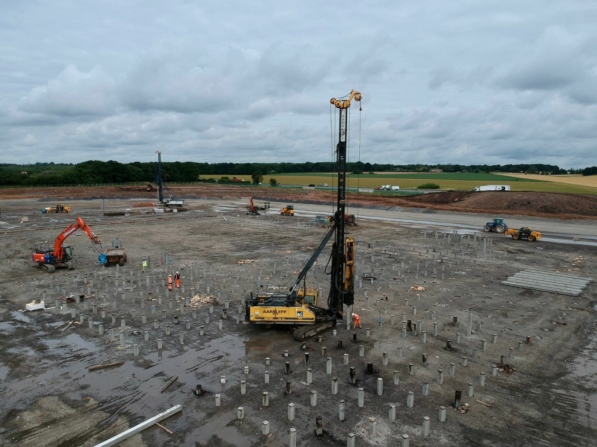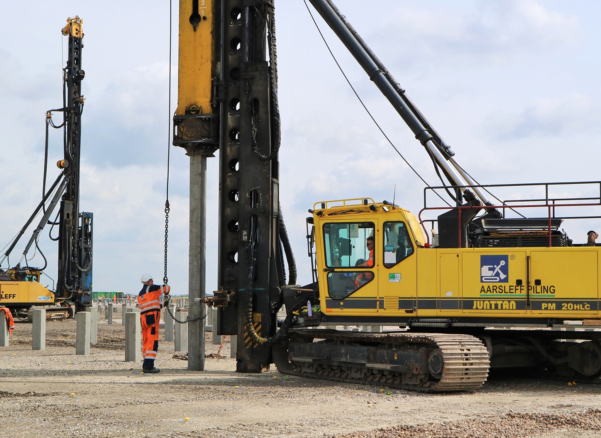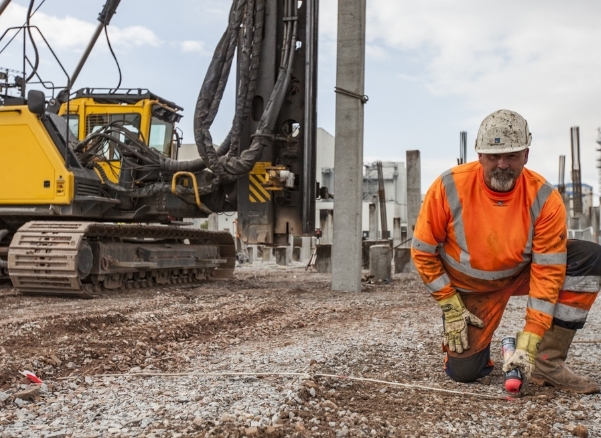What Are Deep Foundations?
Table of Contents
- About Deep Foundations
- Applications of Deep Foundations
- Types of Deep Foundations
- Advantages of Deep Foundations
- Disadvantages of Deep Foundations
About Deep Foundations
A deep foundation is a type of foundation that extends several meters below the ground surface and transfers the weight of a building down to the earth. Unlike shallow foundations, which distribute loads near the surface, deep foundations transfer loads through weak or compressible soils to more competent layers at greater depths. Typically, the ratio of depth to width for these foundations is more than 4 to 5. [1]
The primary purpose of deep foundations is not only to support heavy structural loads but also to handle moments and lateral forces, making them indispensable in many ground engineering projects.

Applications of Deep Foundations
Deep foundations are used across a wide variety of sectors and projects due to their ability to transmit structural loads. Some common applications of deep foundations include:
- Skyscrapers – Tall structures such as skyscrapers with heavy vertical loads depend on deep foundations to maintain stability and prevent settlement.
- Bridges and Overpasses – Bridges and overpasses often require deep foundations to combat the forces associated with vehicle loads.
- Marine and Offshore Structures – Offshore oil rigs, wind turbines, and port facilities often use deep foundations for anchoring into seabeds.
- Industrial Facilities – Large factories, warehouses, and plants with heavy machinery use deep foundations to manage concentrated load distribution.
- Historic Buildings – In historic buildings, deep foundations allow for modern construction with minimal impact on the surroundings.
- Challenging Ground Conditions – In areas with soft or weak soils, deep foundations provide essential support where shallow foundations would fail.
Types of Deep Foundations
There are multiple types of deep foundations, each suited to different site conditions and project requirements [2]:
- Pile Foundations – Pile foundations involve the use of long, vertical columns called piles, which are either driven, drilled or cast into the ground. These piles are typically made from steel or concrete. They are constructed to distribute loads evenly and provide structural support.
- Basements – A basement is a hollow substructure situated underneath a house or building that provides additional space below ground level. It also acts as structural support, distributing the weight of the building to the ground.
- Caissons – These cylindrical, watertight structures are often used in deep water or soft soil and are employed in the construction of offshore structures such as bridges, piers and docks. Caissons are usually constructed on land before being sunk into the ground to a specific depth and filled with concrete.
- Shaft Foundations – Also known as drilled shafts, drilled piers or bored piles, shaft foundations are large-diameter concrete cylinders constructed by drilling a hole into the ground, adding reinforced steel and then filling it with concrete. They are suitable for evenly distributing weight between the foundation and the structure.
- Buoyancy Rafts – Buoyancy rafts, also referred to as hollow box foundations or floating foundations, are ideal for structures built on weak or soft soil to prevent flooding. In buoyancy rafts, the soil underneath the foundation is removed, creating a hollow space for the foundation to be built on. This type of foundation spreads the weight of the building over a large area to keep the structure stable and to prevent excessive sinking into the ground.

Advantages of Deep Foundations
Deep foundations offer a few advantages [3]:
- Increased Load-Bearing Capacity – Deep foundations reach subsoils or rock layers that are much stronger than the surface materials, allowing them to support heavier loads. This is especially critical for tall structures like skyscrapers or heavy infrastructure like bridges, where surface soils cannot adequately support the structure’s weight.
- Adaptability – These foundations can be adapted to a wide range of soil types and conditions. Whether the challenge is soft soil, high water tables, or variable soil layers, deep foundations can be designed to effectively handle the specific circumstances of the site.
- Reduced Settlement – Deep foundations provide stability by anchoring into competent strata well below the surface, which often leads to minimal settlement compared to shallow foundations. This reduces the risk of uneven settling, which can lead to structural damage over time.
- Flexibility in Design – Engineers can choose from various types of deep foundations (e.g., piles, caissons, drilled shafts) depending on the project’s needs, allowing customisation in design to optimise both performance and cost.
- Resistance to Lateral Forces – In addition to vertical loads, deep foundations can resist horizontal forces better than shallow foundations. This is particularly beneficial for structures exposed to wind or water flow, providing increased stability under these conditions.
- Seismic Resistance – Deep foundations can be particularly effective in seismic zones. They can be designed to absorb and dissipate energy, reducing the impact of earthquake forces on the structure. This is crucial for minimising damage during seismic events and is a key consideration in regions prone to such natural disturbances.
Disadvantages of Deep Foundations
Despite their advantages, deep foundations have some drawbacks [3]:
- Cost – Deep foundations are significantly more expensive than shallow foundations. The increase in costs is due to the requirement for specialised machinery and materials, deeper excavation, and more complex construction techniques. The design and installation involve extensive labour and advanced skills, which also add to the overall budget.
- Time-Consuming – The construction of deep foundations is a time-intensive process. It involves multiple stages, including site investigation, design, preparing the site, installing the foundation elements, and backfilling. Each stage must be carefully managed and can be delayed by factors like weather, equipment availability, or unforeseen subsoil conditions. This increased time frame can affect the overall project schedule detrimentally.
- Noise and Vibration – The installation of deep foundations typically requires heavy machinery such as pile drivers and drilling rigs. The operation of these machines generates high levels of noise and vibrations, which can be a major disturbance to nearby residents and businesses.
- Corrosion – Deep foundations, particularly those constructed with steel, are susceptible to corrosion from water, rocks, and natural forces, which can affect their strength and structural integrity.
- Maintenance Challenges – Maintaining and repairing deep foundations can be challenging. Addressing issues and making modifications requires specialised equipment or techniques, leading to high maintenance costs.
- Environmental Impact – The installation process of deep foundations can have a significant impact on the environment, including disruption of the groundwater flow and soil disturbance from noise and ground vibration.

Sources
- Geoengineer.org. (2019). Deep Foundations. Retrieved 15th April 2025, from:
https://www.geoengineer.org/education/foundation-design-construction/deep-foundations - DOZR. (2024). Deep Foundations Explained: What they Are and When to Use Them. Retrieved 15th April 2025, from:
https://dozr.com/blog/deep-foundations-explained - The GeoTech. (n.d). Advantages and Disadvantages of Deep Foundation. Retrieved 15th April 2025, from:
https://thegeotech.com/advantages-and-disadvantages-of-deep-foundation/








